I look forward to the early -ber months in Laguna because I can enjoy one of my favorite seasonal fruits, the lanzones!
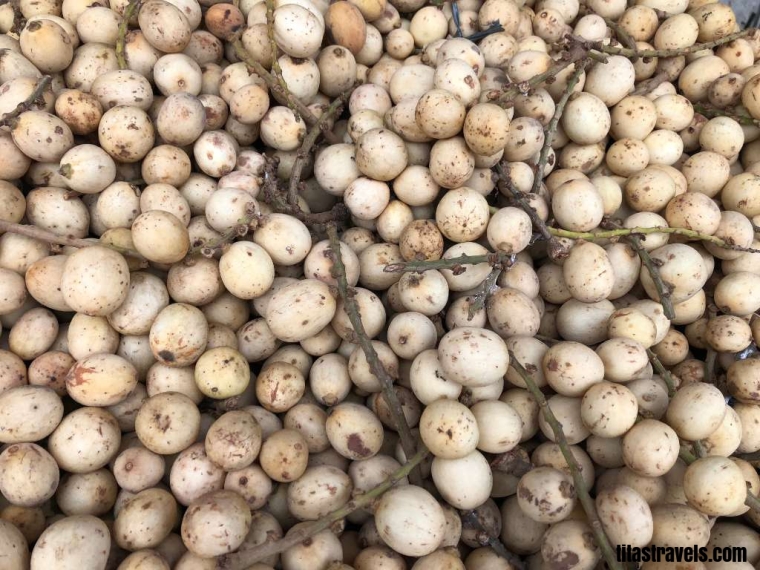
For our foreign readers, LANZONES (Lansiumparasiticum) is a seasonal, tropical, exotic, and edible fruit which originated in West Malaysia and is widely grown in the Philippines and other parts of Southeast Asia.
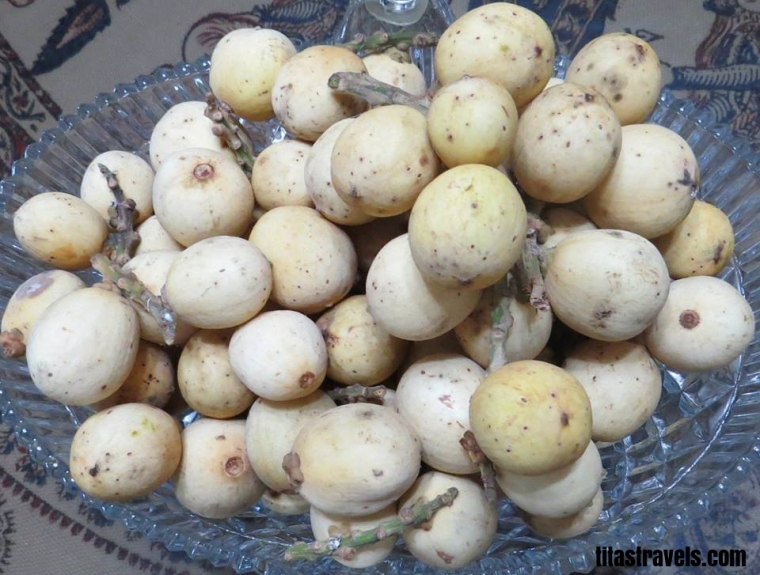
Clustered like grapes, this fruit is elliptical, ovoid, or round, measuring 2-7 cm (0.79-2.76 in.) by 1.5-5 cm (0.59-1.97 in.) in size.
It has a thin, leathery, slightly-fuzzy yellow skin that varies in thickness from 2-6 mm (0.079-0.24 in.). The yellow skin will gradually develop brownish-black spots as the days go by as this fruit spoils quickly and does not have a long shelf life. So, eat it immediately after purchase. My advice is to buy only what you can consume within 2 days.
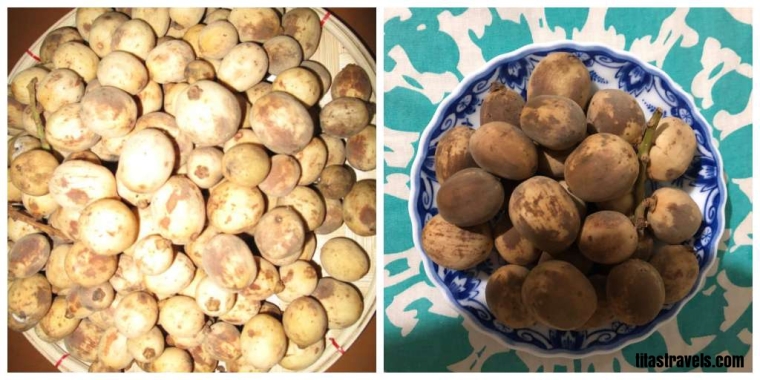
This year, fruits were harvested in early September in Laguna, and priced at 80-90 pesos per kilo (2018). I personally prefer the smaller variety since I find that they are sweeter and have smaller seeds, if any at all.
Lanzones is known under a variety of common names worldwide: bhubi (Bengali), bon bon (Vietnamese), buahan (Cebuano), buwa-buwa (Tagalog), ceruring (Balinese), dau da dat (Vietnamese), dhuku (Javanese), dokong (Malay), duku (Burmese, Indonesian, Malay), gaduguda (Sinhalese), kokosan (Indonesian), langsak (Burmese), langsat (English, Indonesian, Malay, and Thai for thin-skinned variety), langseh (Malay), langsep (Javanese, Malay), lansa (Malay), lansones (Cebuano. Tagalog), lanzones (English), lon bon (Vietnamese), long kong (Khmer), longkong (Thai, for thick-skinned variety), lotka (Bengali), and pangkai (Mizo language).
The larger variety of lanzones is called Duku. It has large round fruits, a thicker skin, and some consider it sweeter than the smaller variant.The hybrid between Duku and Langsat is called Duku-Langsat. Another variation is Longkong, or Dokong, introduced in Indonesia and Thailand. This variant has a thick skin, sweet aromatic taste, no latex, only a few seeds or is seedless.1
Lanzones is grown in different parts of the Philippines: Camiguin (known to yield the sweetest lanzones during the month of October), Laguna (fruits harvested from September to November, depending on the onset of typhoons and strong winds which may affect the flowering stage), Butuan, Cagayan de Oro, and Northern Mindanao.2
The Lanzones Festival is held annually in Camiguin Island for 4 days during the 3rd week of October, to celebrate their lanzones harvest, the precious livelihood of the residents there.3
Legend says that this fruit was originally poisonous.3 The name itself, lanzones, comes from the Filipino term for poison – lason! It is said that there was once a town with bountiful trees which bore round and pale-colored fruits, but the people were afraid to eat them. They saw a man who tried to eat a fruit, but he died as soon as it touched his lips. This made the people afraid of even touching the fruit. Then, one day, the town suffered from drought, food became scarce, and the people became hungry. Suddenly, a mysterious lady came to town, sang and danced in the streets, picked a fruit from the poisonous tree, pinched it, and ate it. To the amazement of the people, the lady did not die. She claimed that as she pinched the fruit, she took out the poison. She then asked the townfolk to eat the fruits, and famine eventually ended.2
A second version of its origin goes like this: lanzones was poisonous and extremely sour but one day, a woman (believed to be the Virgin Mary) and Her Child (the Baby Jesus) travelled along a road, were very hungry, and found only lanzones trees all around. Having no other option to eat, they ate the fruits and, henceforth, the lanzones became edible and sweet.4
The fruits, when allowed to ripen on the branches of the tree, are attractive to flying animals at night, like bats. The people from Paete, Laguna, in the Philippines, hang kerosene lamps on the trees to repel bats and other nocturnal animals.1
When completely ripe, the fruit is eaten as is, or added to cooked/processed dishes/items. Its thin skin is opened by pinching/squeezing the stem end until the skin opens and is then further easily peeled back to reveal about 5-6 translucent white, smooth, juicy and sweet (sometimes, a bit tart or sour) fleshy segments, which, together, may have 1-3 dark green, bitter-tasting, inedible seeds of different sizes. Break the segments apart, and eat them one by one. Discard the inedible seeds, if any.
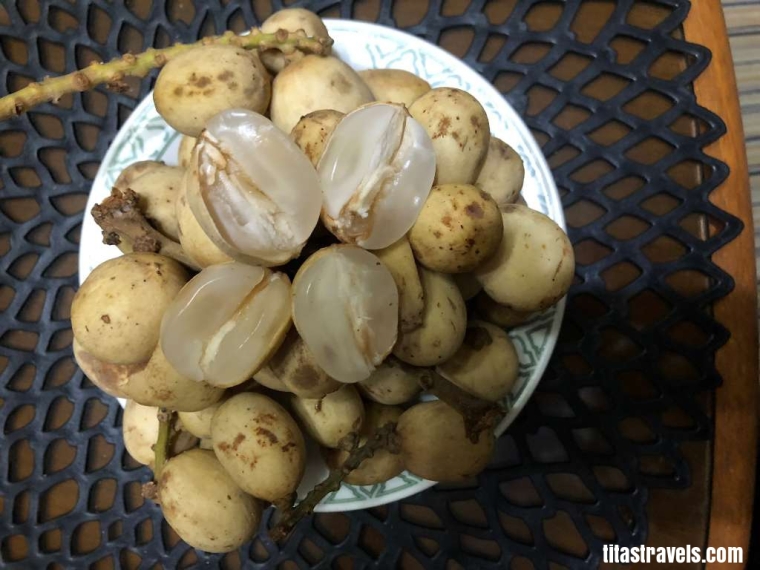
Peeling may yield a milky latex, especially when newly picked/harvested, that may stain your fingers with a slightly sticky blackish-brown sap. Personally, I do not mind this sap because this fruit is one of my top favorite fruits.
However, if you are turned off by the black sap on your fingertips after consuming a sizeable amount of this fruit, worry no more! There are 5 ways to avoid/address this concern: (a) use a paper towel when removing the skin; (b) apply oil to your fingertips to avoid the stickiness; (c) dip the fruit into boiling water to eliminate the sticky substance; (d) apply alcohol on stained fingers and wipe off with a paper napkin;3 or, (e) my dear father taught me to simply rub my stained fingers through my hair several times till all the sticky sap is gone. He said the natural oil in my hair removes the sticky, sappy dark stains, and you know what? It works! But if I do this, I see to it that I shampoo my hair thereafter. Try all these techniques and tell me what really works for you!
Lanzones is used in beverages, desserts, fruit salads, jams and jellies. Its fleshy segments are added to curries and soups. These are also added to other fruits like bananas, pomegranates and strawberries, to make popsicles.3
Each segment contains fructose, glucose and sucrose. It also contains carbohydrates, fiber, pantothenic acid, protein, riboflavin, thiamine, vitamins A, B1 (thiamine), B2 (riboflavin), B3 (niacin), C, and minerals, such as calcium, copper, iron, magnesium, manganese, phosphorus, potassium, and zinc.3 This fruit is low in fat so this is good for weight-watchers! It has antibacterial, anti-inflammatory, and antimicrobial properties, as well as an abundance of natural antioxidants (e.g., polyphenols) that can help the body to fight disease-causing free radicals.5
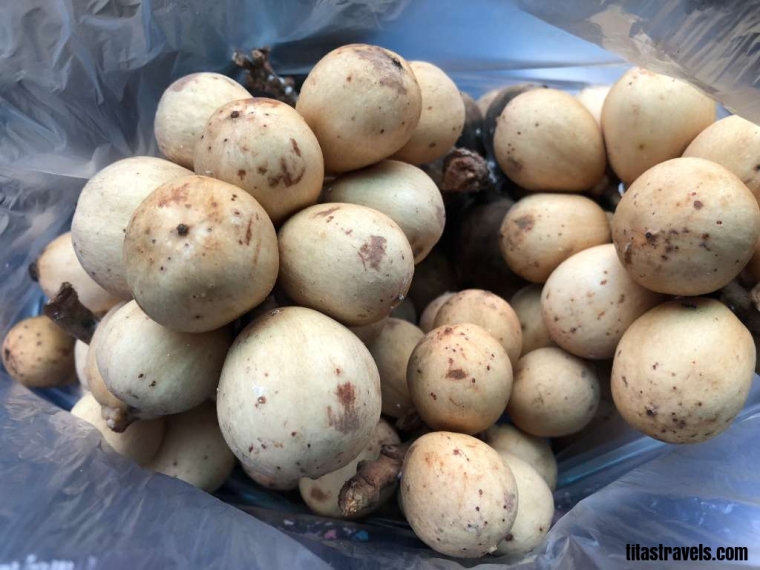
This fruit is considered a healthy snack for people with diabetes because of its high fiber content, along with the presence of the antioxidant polyphenol, which improves glucose levels by slowing down the absorption of sugar.3
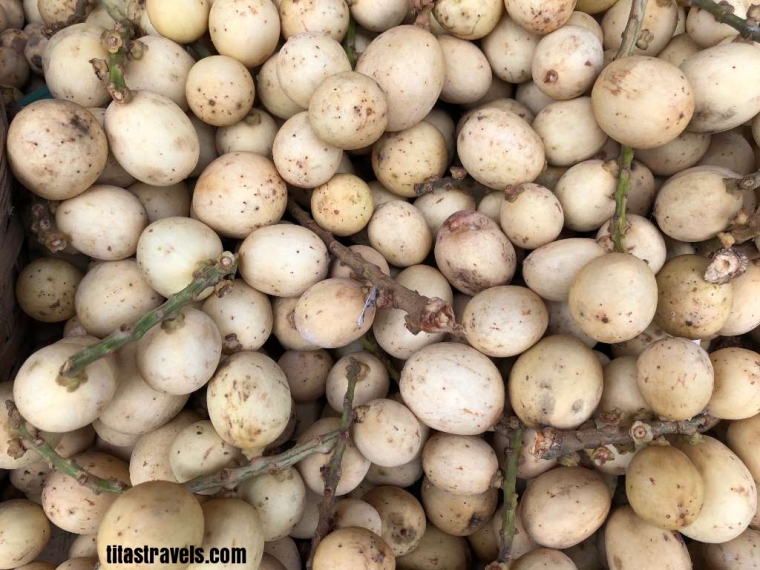
There are no known side effects when eating this fruit. However, this fruit is known to cause gas so overconsumption is not good for people who easily bloat. Also, pregnant women should consult their doctors before eating lots of this yummy fruit.3
The bark, leaves and/or segments are known to: aid in weight loss; be effective in de-worming; boost the immune system; cure dysentery, malaria, scorpion stings and ulcers; improve metabolism; reduce cholesterol levels; regulate blood sugar levels; relieve diarrhea and eye inflammation; and treat bloating and fever.
Did you know that the dried skin of lanzones is traditionally used in the Philippines as a natural mosquito repellant? I recall my Dad who used to sun-dry the peels and light them up in our terrace during night time. The smell was pleasant and guess what? I had no mosquito bites!
So, what are you waiting for? Go to your nearest fruit stand while supply lasts!
Most of the information was obtained from the Wikipedia page, “Lansium parasiticum”.6
Did you find this post informative? I would like to hear from you. Simply scroll and click “Leave a comment”. Do share this post with your Facebook friends, follow me by clicking on the bottom right corner of your device, and do not forget to like this post. Thank you!
– – – – – – – – – – – – – – – – – – – – – – – – –
6”Lansium parasiticum,” accessed September 8, 2018, https://en.wikipedia.org/wiki/Lansium_parasiticum


3 thoughts on “Savoring Pinoy Delights: THE LUSCIOUS LANZONES”